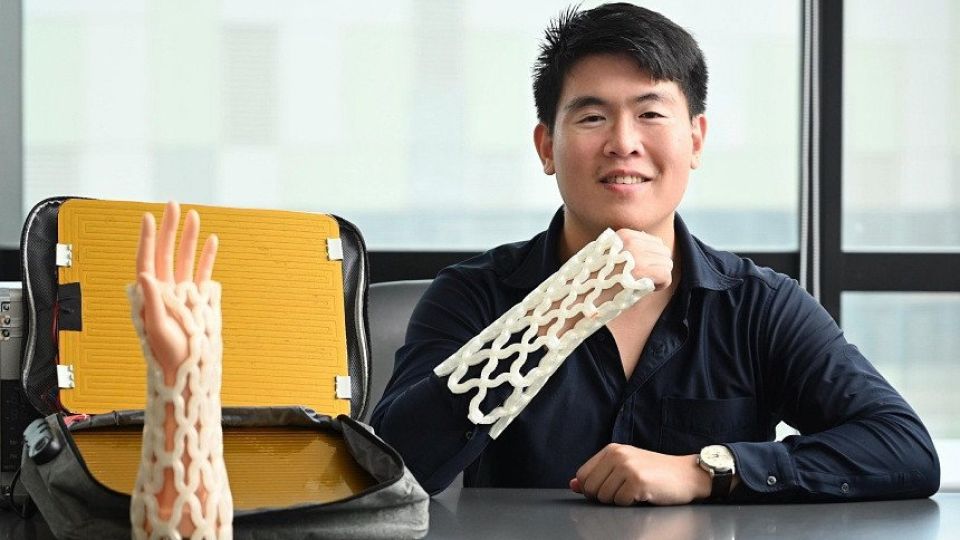September 24, 2024
SINGAPORE – Entrepreneur Abel Teo literally went out on a limb to achieve his goal of wanting to work in a start-up that could solve a real-world problem through innovation and technology.
The opportunity came in 2020 when he met Ms Eleora Teo, a student from the Singapore University of Technology and Design (SUTD), during a venture-building programme.
The 3D-printed casts Ms Teo – no relation to Mr Teo – was trying to develop for broken limbs caught his attention as they sought to address many issues faced by patients with fractures.
“What caught my eye was that the design allows you to shower with it and scratch an itch whenever you like,” Mr Teo said. “It’s also designed to eliminate odours. Have you ever been near an old cast on someone’s arm? With the build-up of gunk and sweat underneath, it’s not the most pleasant smell.”
Mr Teo, Ms Teo and fellow co-founder Johannes Sunarko established Castomize in 2022 to create reusable and mouldable casts for broken bones using 4D-printing technology.
The idea to move from 3D to 4D printing came from Mr Teo, the medtech start-up’s chief executive, who realised that because the thermoplastics used in 4D printing are responsive to heat, they provide a more flexible solution than conventional 3D-printed casts.
Castomize’s 4D-printed casts become malleable when heated, allowing them to conform to a patient’s limb with the appropriate pressure. Once cooled, they harden to provide the necessary support and can also be reshaped as the bone heals.
The casts can also be quickly assembled, taking about four minutes from wrapping to cooling and setting on the patient’s arm, compared with the 15 minutes typically required for conventional casts.
Castomize’s casts are around 30 to 40 per cent more expensive upfront, but they offer long-term savings for patients. The casts cost approximately $25 each to manufacture, compared with around $10 for traditional casts.
“When you fracture a limb, your muscles around that bone will deteriorate and become smaller because you’re not using them, which is why patients need to have a recast once every few weeks. Our casts are reusable, so patients can save money by just having one cast,” said Mr Teo.
He added that clinical trials for Castomize’s casts are still under way at Tan Tock Seng Hospital, but once completed, the firm will be able to start accepting orders from a number of other local healthcare providers. The firm has already shipped casts to medical supply distributors in South Korea, and has also attracted interest from distributors and healthcare providers in Taiwan, Hong Kong, Australia and the Middle East.
Mr Teo, who graduated with a business management degree from Singapore Management University, said the start-up has recently faced several challenges, including meeting distributor demands and explaining the concept of the casts to health professionals.
“One thing about the healthcare industry is that people like to stick to established processes, so when something like our casts come along, it’s a process that is new to healthcare workers, so we actually faced some resistance,” he said.
“But once we explained to them that our casts can help to save costs in the long run, they became more amenable to the idea.”
One distributor was unhappy with the design of the cast’s clasp and requested a change, so the Castomize team worked around the clock for two weeks, even living in the office, to develop a new design.
“Because of that whole process, I think people became aware that we could get things done,” said Mr Teo.
Castomize is exploring other 4D-printing applications in healthcare, such as eyewear and prosthetics, with plans to launch products by mid-2025. It is also looking into the use of 4D printing in the construction industry.
The firm’s casts are produced in Singapore through a contract manufacturer, but it plans to move to mass production in Thailand to reduce costs. Although the company is not yet profitable, it has raised $580,000 from investors, including SUTD and innovation platform Ventureblick, and is seeking additional venture capital funding.
Mr Teo said his biggest takeaway from running Castomize has been the steep learning curve: “There is a lot of learning, because working in the medtech space means that I have to learn how to interact with different stakeholders, from healthcare workers to investors and international distributors.
“It feels as if I’m cramming decades of working at a nine-to-six job into a really short amount of time, so I can safely say that I’ve learnt a lot over the past two years.”
His top three tips for young aspiring entrepreneurs:
- Identify a problem before coming up with a solution; too many start-up founders try to develop an expensive solution for a non-existent problem.
- Be honest with yourself and accept feedback without ego.
- Simplify your workflow so that you have the headspace to develop the best product.


